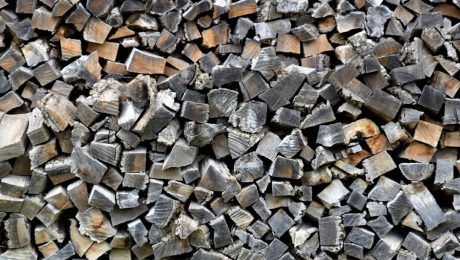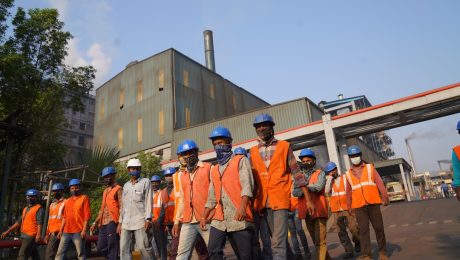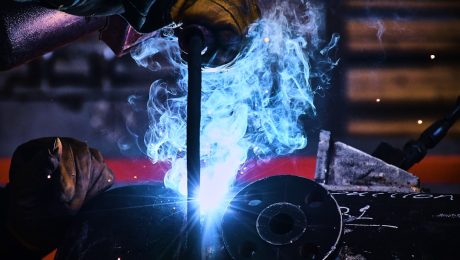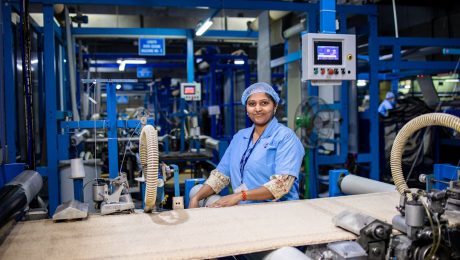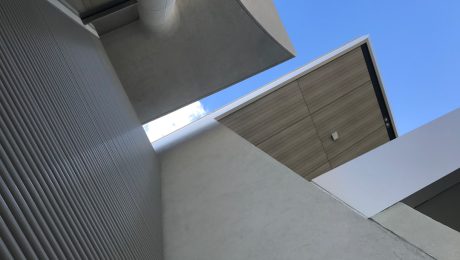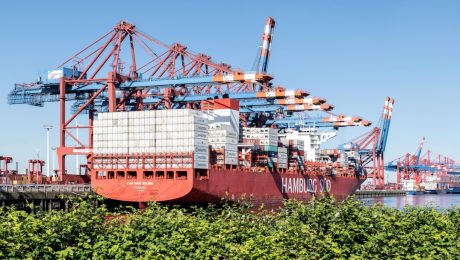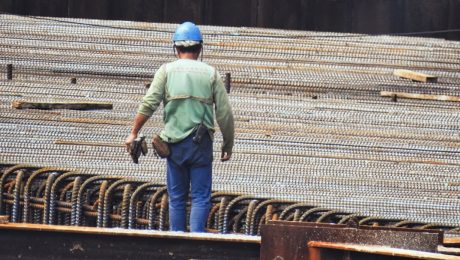Multi-story steel buildings are increasingly becoming the preferred choice for a wide range of applications, from commercial offices and residential apartments to industrial facilities and mixed-use developments. Their versatility, strength, and efficiency make them a compelling alternative to traditional concrete structures. This comprehensive guide delves into the key aspects of designing, constructing, and benefiting from multi-story steel building solutions.
1. The Advantages of Choosing Steel for Multi-Story Construction
Steel offers several significant advantages over other construction materials for multi-story buildings:
- High Strength-to-Weight Ratio: Steel’s exceptional strength allows for the creation of lighter structures, reducing foundation requirements and overall construction costs. This is especially crucial in high-rise buildings where weight is a major factor.
- Speed and Efficiency of Construction: Pre-fabricated steel components can be assembled quickly on-site, significantly reducing construction time compared to traditional methods. This translates to faster project completion and reduced labor costs.
- Design Flexibility and Versatility: Steel’s malleability allows for complex and innovative designs, accommodating various architectural styles and functional requirements. Curved walls, large open spaces, and intricate facades are all readily achievable.
- Sustainability and Recyclability: Steel is a highly recyclable material, contributing to environmentally friendly construction practices. The use of recycled steel also reduces the demand for newly mined resources.
- Durability and Longevity: With proper maintenance, steel structures can withstand harsh weather conditions and last for decades, minimizing long-term maintenance costs.
- Seismic Resistance: Steel’s inherent ductility allows it to absorb seismic energy more effectively than concrete, making it a safer option in earthquake-prone regions.
2. Design Considerations for Multi-Story Steel Buildings
Designing a multi-story steel building requires careful consideration of several factors:
- Structural Analysis and Design: Sophisticated structural analysis is essential to ensure the building’s stability and load-bearing capacity. This involves considering wind loads, seismic activity, and the weight of the building materials and occupants.
- Fire Protection: Steel’s susceptibility to fire necessitates the implementation of appropriate fire protection measures, such as fireproofing coatings or enclosures.
- Connection Design: The design of steel connections significantly impacts the overall structural integrity of the building. High-strength bolts, welds, and other connection methods must be carefully selected and engineered.
- Building Codes and Regulations: Adherence to local building codes and regulations is crucial throughout the design and construction process. This ensures the building’s safety and compliance with legal requirements.
- Architectural Aesthetics: The design should integrate seamlessly with the surrounding environment and meet the client’s aesthetic preferences. This often involves collaboration between architects, engineers, and other stakeholders.
3. Construction Processes for Multi-Story Steel Structures
The construction process for multi-story steel buildings typically involves the following steps:
- Site Preparation: This involves clearing the site, excavating for foundations, and preparing the ground for construction.
- Foundation Construction: Appropriate foundations, such as spread footings, piles, or caissons, are constructed to support the weight of the building.
- Steel Fabrication and Erection: Steel components are fabricated off-site and then transported and erected on-site using cranes and other heavy equipment.
- Connection and Welding: Steel components are connected using high-strength bolts, welds, or a combination of both.
- Fireproofing and Finishing: Fireproofing measures are applied to the steel structure, followed by the installation of cladding, roofing, and other building finishes.
- MEP Installation: Mechanical, electrical, and plumbing systems are installed throughout the building.
- Interior Finishes: Interior walls, floors, and ceilings are installed, along with fixtures and fittings.
4. Cost-Effectiveness of Multi-Story Steel Buildings
While the initial cost of steel construction might seem higher than some other materials, the long-term cost-effectiveness is often a significant advantage. Factors contributing to this include:
- Faster Construction Time: Reduced construction time translates to lower labor costs and faster project completion, leading to quicker return on investment.
- Reduced Foundation Costs: The lighter weight of steel structures often reduces the size and cost of foundations.
- Lower Maintenance Costs: Steel’s durability and longevity minimize the need for frequent repairs and maintenance.
- Increased Property Value: Buildings constructed with high-quality materials often command higher property values.
- Improved Energy Efficiency: Properly designed steel buildings can incorporate energy-efficient features, leading to lower operational costs.
5. Choosing the Right Steel Building Contractor
Selecting a reputable and experienced steel building contractor is crucial for the successful completion of your project. Consider the following factors when choosing a contractor:
- Experience and Expertise: Look for a contractor with a proven track record of successfully completing multi-story steel building projects.
- Safety Record: Prioritize contractors with a strong commitment to safety and a low accident rate.
- Financial Stability: Ensure the contractor has the financial resources to complete the project on time and within budget.
- References and Testimonials: Check references and testimonials from previous clients to gauge the contractor’s reputation and performance.
- Project Management Capabilities: A well-organized and efficient project management team is essential for successful project execution.
By carefully considering these factors, you can ensure the successful design and construction of a robust, efficient, and aesthetically pleasing multi-story steel building.
Tags: multi-story steel buildings, steel construction, high-rise steel buildings, steel building design, structural steel
The steel industry, a cornerstone of global infrastructure, faces a critical challenge: its significant contribution to greenhouse gas emissions. Traditional steelmaking processes are energy-intensive and rely heavily on coal, resulting in substantial carbon dioxide release. However, a revolution is underway, driven by the urgent need for sustainable practices. This post explores the innovative approaches transforming steel manufacturing into a greener, more environmentally responsible industry.
1. Hydrogen-Based Steelmaking: A Paradigm Shift
The most promising pathway towards eco-friendly steel production lies in replacing coal with hydrogen as the primary reducing agent in the blast furnace. Traditional steelmaking uses coke (derived from coal) to reduce iron ore, releasing vast amounts of CO2. Hydrogen, however, reacts with iron ore to produce iron and water vapor, a significantly cleaner byproduct. This process, known as Direct Reduced Iron (DRI) with hydrogen, eliminates direct CO2 emissions from the reduction stage. While the production of green hydrogen (hydrogen produced using renewable energy sources) currently presents challenges in terms of cost and scalability, significant advancements are being made in electrolysis technologies and renewable energy integration, making hydrogen-based steelmaking increasingly feasible. Furthermore, research into alternative hydrogen carriers and storage methods is also accelerating the transition towards this cleaner technology.
2. Carbon Capture, Utilization, and Storage (CCUS): Trapping Emissions
Even with advancements in hydrogen-based steelmaking, a complete elimination of CO2 emissions in the short term may be unrealistic. Therefore, Carbon Capture, Utilization, and Storage (CCUS) technologies play a crucial role in mitigating the environmental impact of existing and transitional steel production processes. CCUS involves capturing CO2 emissions from blast furnaces and other steelmaking processes, preventing their release into the atmosphere. The captured CO2 can then be utilized in various industrial applications, such as enhanced oil recovery or the production of chemicals, or stored securely underground in geological formations. While CCUS technologies are still under development and require significant investment, they represent a vital bridge towards a lower-carbon steel industry, enabling a gradual transition to cleaner processes.
3. The Circular Economy Approach: Recycling and Resource Efficiency
Steel is inherently recyclable without significant loss of quality, making it a prime candidate for a circular economy approach. Recycling steel scrap reduces the demand for virgin iron ore, significantly lowering energy consumption and greenhouse gas emissions compared to producing steel from raw materials. Implementing efficient scrap collection and sorting systems, as well as investing in advanced recycling technologies, is crucial for maximizing the benefits of steel recycling. Furthermore, designing steel products for recyclability, such as avoiding the use of incompatible materials, contributes to a more efficient and sustainable steel lifecycle. The circular economy approach not only reduces the environmental footprint of steel production but also offers economic advantages through resource optimization and waste reduction.
4. Process Optimization and Energy Efficiency: Reducing the Footprint
Beyond fundamental changes in the production process, optimizing existing steelmaking operations plays a significant role in reducing the industry’s environmental impact. Improving energy efficiency through technological advancements, such as advanced process control systems and waste heat recovery, can significantly reduce energy consumption and associated emissions. Implementing best practices in maintenance and operation can further enhance energy efficiency and reduce operational costs. Investing in renewable energy sources to power steel mills also contributes to decarbonizing the industry, reducing reliance on fossil fuels.
5. Policy and Regulatory Frameworks: Driving the Transition
Government policies and regulations play a crucial role in driving the transition towards eco-friendly steel manufacturing. Carbon pricing mechanisms, such as carbon taxes or emissions trading schemes, can incentivize steel producers to adopt cleaner technologies and reduce their carbon footprint. Furthermore, government support for research and development in green steel technologies, as well as financial incentives for the adoption of sustainable practices, are essential for accelerating the transition. Stringent environmental regulations, coupled with clear targets for emissions reduction, create a framework that compels the industry to innovate and adapt to a more sustainable future. International collaboration on standards and best practices is also crucial for ensuring a globally coordinated effort towards decarbonizing the steel industry.
The journey towards eco-friendly steel manufacturing is complex and multifaceted, requiring a collaborative effort from industry stakeholders, governments, and researchers. However, the innovations discussed above demonstrate a clear path towards a sustainable future for this crucial industry, paving the way for a greener and more responsible global economy.
Tags: green steel, eco-friendly steel, sustainable steel manufacturing, hydrogen steelmaking, carbon capture
High Elastic Limit (HEA) steel profiles are increasingly popular in the construction of heavy load structures due to their superior strength and efficiency. This comprehensive guide explores the key aspects of designing with HEA profiles, offering insights for engineers and architects tackling demanding projects.
Understanding HEA Steel Properties and Advantages
HEA steel, characterized by its high yield strength and elastic limit, offers significant advantages over traditional structural steel sections. This superior strength allows for the use of lighter sections, reducing material costs and overall structural weight. The increased elastic limit means the material can withstand greater stress before yielding, enhancing the structural integrity and safety of the project. HEA steel also exhibits excellent weldability and formability, simplifying fabrication processes. However, it’s crucial to understand that while stronger, HEA steel can be more brittle than standard steel, requiring careful consideration during the design phase to mitigate potential risks associated with impact loading or fatigue.
Choosing the Right HEA Profile for Your Project
Selecting the appropriate HEA profile is paramount for structural integrity and efficiency. Several factors influence this choice, including the anticipated load, span length, support conditions, and overall design requirements. Detailed load calculations, using appropriate safety factors, are essential. Software tools like finite element analysis (FEA) can significantly aid in determining optimal HEA profiles and verifying structural performance under various load scenarios. Consideration should also be given to the availability of specific HEA profiles from manufacturers and the logistical implications of transportation and handling of larger, heavier sections. The profile’s geometry – whether I-beam, H-beam, or other variations – will also impact its moment of inertia and section modulus, influencing its bending resistance.
Design Considerations for Heavy Load Structures with HEA Profiles
Designing with HEA steel requires a nuanced approach that differs from traditional steel design. The higher strength necessitates careful attention to detailing to prevent premature failure due to stress concentrations. Proper connection design is critical; welds must be meticulously executed and inspected to ensure sufficient strength and prevent cracking. The use of high-strength bolts may also be necessary for certain connections. Buckling, particularly lateral-torsional buckling, needs careful analysis and mitigation strategies, potentially involving bracing or stiffeners. Furthermore, the potential for brittle fracture in HEA steel mandates considering the impact of low temperatures and potential flaws in the material during the design process. Detailed analysis, incorporating relevant design codes and standards, is crucial for ensuring the safety and longevity of the structure.
Fabrication and Construction Techniques for HEA Steel
The fabrication and construction of structures using HEA profiles demand specialized expertise. The higher strength of HEA steel requires precise cutting, welding, and handling techniques to avoid damage to the material. Specialized welding procedures and qualified welders are essential to ensure the integrity of the welds. Proper handling equipment is necessary due to the increased weight of the HEA sections compared to traditional steel profiles. To minimize on-site challenges, prefabrication of components in controlled environments is often preferred. Detailed shop drawings and stringent quality control measures are crucial throughout the entire process, from material procurement to final erection. This meticulous approach helps guarantee the accuracy and quality of the finished structure.
Case Studies and Application Examples of HEA Profiles
Numerous successful projects demonstrate the effectiveness of HEA profiles in heavy load structures. These include large-span bridges, high-rise buildings, industrial platforms, and offshore structures. In bridge construction, HEA beams can significantly reduce the overall weight and material costs while maintaining the required structural capacity. High-rise buildings utilizing HEA steel can achieve greater height and floor area with fewer columns. Industrial platforms benefit from the increased load-bearing capacity of HEA profiles, allowing for the placement of heavier equipment. Offshore structures, subjected to extreme environmental conditions, rely on the high strength and durability of HEA steel to withstand harsh marine environments. Examining these case studies reveals best practices, highlighting the successful integration of HEA profiles into diverse and challenging projects. Analyzing these real-world applications provides valuable insights into efficient design and construction methodologies.
By understanding the properties, design considerations, and application examples of HEA steel profiles, engineers and architects can leverage their superior strength and efficiency to create safer, more economical, and sustainable heavy load structures.
SEO Tags:
- HEA steel
- Heavy load structures
- Structural steel design
- High strength steel profiles
- Engineering design
Steel is a ubiquitous material in modern civil engineering, forming the backbone of countless structures from skyscrapers to bridges. A strong understanding of steel design, analysis, and construction is therefore crucial for any aspiring or practicing civil engineer. This comprehensive guide delves into the essential aspects of steel training, highlighting key areas of knowledge and practical application.
Understanding the Fundamentals of Steel Design
Before tackling complex steel structures, a solid foundation in the fundamental principles of steel design is paramount. This includes a thorough grasp of material properties, such as yield strength, tensile strength, and ductility. Understanding the behavior of steel under various loading conditions, including tension, compression, bending, and shear, is critical. This foundational knowledge forms the bedrock for all subsequent learning and practical application. Courses often cover relevant design codes and standards, such as AISC (American Institute of Steel Construction) or Eurocode 3, which dictate permissible stresses and design methodologies. Learning to interpret these codes and apply them correctly is a vital skill for any steel design engineer.
Mastering Steel Structural Analysis Techniques
Once the fundamental properties are understood, the next step involves mastering structural analysis techniques specific to steel. This includes analyzing various structural elements like beams, columns, and trusses under different loading scenarios. Traditional methods such as moment distribution and slope-deflection are still relevant, but modern engineers rely heavily on computer-aided analysis using Finite Element Analysis (FEA) software. Understanding the principles behind these analytical methods, as well as their limitations, is crucial for accurate and reliable designs. Proficiency in using FEA software packages is highly sought after in the industry and often forms a significant part of steel training programs. It’s essential to understand how to model steel structures accurately, interpret the results, and use this information to inform design decisions.
Practical Application: Steel Construction and Detailing
Theory is only half the battle. A comprehensive understanding of steel construction practices is equally important. This involves familiarity with various steel fabrication techniques, including welding, bolting, and the use of high-strength fasteners. Steel detailing, the process of creating precise drawings for fabricators, is a critical aspect of steel construction. Effective detailing ensures that the fabricated members fit together correctly and meet the design requirements. Furthermore, understanding the implications of fabrication tolerances and potential construction challenges is crucial for creating robust and efficient designs. Practical experience, often gained through internships or on-site visits, complements classroom learning significantly.
Advanced Topics in Steel Design: Connections and Stability
Beyond the basics, advanced topics like steel connections and stability analysis are crucial for designing complex and high-performance structures. Steel connections are the critical elements that transmit forces between different structural members. Proper design of connections is vital for the overall stability and strength of the structure. This involves understanding different connection types (e.g., bolted, welded, moment connections), their behavior under load, and the relevant design provisions in codes. Furthermore, understanding and addressing stability issues, such as buckling in columns and lateral-torsional buckling in beams, is crucial for ensuring structural integrity. Advanced training programs delve into these areas, often incorporating specialized software and case studies of complex structures.
Utilizing Software for Steel Design and Analysis
Modern steel design relies heavily on specialized software. Programs like AutoCAD, Revit, Tekla Structures, and various FEA packages (e.g., ABAQUS, ANSYS) are indispensable tools for engineers. Steel training programs should incorporate hands-on experience with these software packages, teaching students how to model structures, perform analyses, and generate detailed drawings. Familiarity with these tools significantly increases efficiency and accuracy in the design process. Understanding the capabilities and limitations of different software packages is essential for making informed decisions about which tools to utilize for specific projects. The ability to interpret and effectively utilize software outputs is a key skill sought after by employers.
In conclusion, comprehensive steel training for civil engineers is a multifaceted endeavor that combines theoretical knowledge, analytical skills, and practical experience. By mastering the fundamentals of steel design, structural analysis techniques, construction practices, and relevant software, civil engineers can confidently contribute to the design and construction of safe, efficient, and innovative steel structures. Continuous learning and staying updated with the latest advancements in materials and technology are essential for success in this dynamic field.
SEO Tags:
- Steel Training Civil Engineers
- Steel Design Courses
- Steel Structure Analysis
- Steel Construction Training
- Structural Steel Design Software
Navigating the complex world of steel procurement can be challenging. From understanding diverse steel grades and specifications to ensuring quality and managing supply chains, steel buyers face numerous hurdles. This is where expert technical consulting steps in, offering invaluable support and expertise to optimize your steel purchasing strategy and achieve significant cost savings and operational efficiency.
1. Optimizing Steel Grade Selection for Your Application
Choosing the right steel grade is paramount. Incorrect selection can lead to project delays, structural failures, and significant financial losses. Our technical consultants possess deep knowledge of various steel grades (carbon steel, alloy steel, stainless steel, etc.), their properties, and their suitability for different applications. We analyze your specific project requirements – including intended use, environmental conditions, load-bearing capacity, and budget constraints – to recommend the most cost-effective and performance-optimized steel grade. This includes detailed analysis of material data sheets, tensile strength, yield strength, ductility, and other critical properties to ensure perfect alignment with your needs. We go beyond simple grade selection; we help you understand the trade-offs between different grades, ensuring you make informed decisions based on a comprehensive understanding of your project’s specifics.
2. Navigating Complex Steel Specifications and Standards
The steel industry utilizes numerous standards and specifications (ASTM, ASME, EN, JIS, etc.). Understanding these standards is crucial for ensuring compliance, quality, and avoiding costly mistakes. Our consultants provide expert guidance in interpreting these specifications, helping you understand the nuances of chemical composition, mechanical properties, and testing requirements. We help you select the appropriate standards for your project and ensure that the steel you purchase meets all necessary regulatory requirements. We also assist in drafting precise specifications to communicate your needs effectively to suppliers, minimizing ambiguity and potential disputes.
3. Implementing Robust Steel Quality Control Procedures
Maintaining consistent steel quality throughout the supply chain is vital. Our consultants help you establish and implement rigorous quality control procedures, from initial material selection to final product inspection. This includes developing inspection plans, defining acceptance criteria, and overseeing testing procedures to ensure that the delivered steel conforms to the specified requirements. We leverage our network of accredited testing laboratories and experts to provide independent verification of steel quality, giving you confidence in your materials. We also advise on implementing traceability systems to track the steel’s origin and history, crucial for identifying and resolving potential quality issues.
4. Streamlining Your Steel Supply Chain Management
Efficient supply chain management is critical for on-time project delivery and cost optimization. Our consultants help you optimize your steel sourcing strategies, identifying reliable suppliers, negotiating favorable contracts, and managing logistics effectively. We analyze your procurement process, identifying bottlenecks and inefficiencies, and recommend strategies for improvement. This includes developing robust inventory management systems, implementing just-in-time delivery strategies, and optimizing transportation routes to reduce costs and minimize lead times. We also assist in risk mitigation strategies, helping you navigate potential supply chain disruptions and ensure a consistent flow of high-quality steel.
5. Leveraging Technology for Enhanced Steel Procurement
Technology is transforming the steel industry, offering new opportunities for improved efficiency and cost savings. Our consultants advise on the implementation of advanced technologies such as data analytics, cloud-based platforms, and digital twinning to optimize your steel procurement process. We can help you leverage data-driven insights to make informed decisions about steel selection, supplier selection, and inventory management. This includes integrating your procurement systems with your ERP and other enterprise systems for seamless data flow and improved decision-making. We also explore the use of digital tools for material tracking, quality control monitoring, and supply chain visibility, enhancing transparency and accountability throughout the process.
By partnering with our technical consulting team, steel buyers can gain a competitive edge, ensuring they receive the right steel, at the right price, and at the right time. Contact us today to discuss your specific needs and discover how we can help you unlock the full potential of your steel procurement strategy.
SEO Tags:
- Steel Buying
- Technical Steel Consulting
- Steel Procurement Optimization
- Steel Quality Control
- Steel Supply Chain Management
body { font-family: sans-serif; line-height: 1.6; }
h1, h2, h3 { color: #333; }
h1 { font-size: 2.5em; }
h2 { font-size: 2em; }
h3 { font-size: 1.5em; }
p { margin-bottom: 1em; }
ul { list-style-type: disc; margin-left: 20px; }
Navigating the complex world of European manufacturing standards can be daunting. This comprehensive guide will demystify the process of meeting EN standards, helping your manufacturing business achieve compliance and unlock significant advantages in the marketplace.
Understanding EN Standards: A Foundation for Quality
EN standards, developed by the European Committee for Standardization (CEN), represent a crucial set of technical specifications for products, processes, and services across Europe. Compliance with these standards signifies a commitment to quality, safety, and interoperability. These standards cover a vast range of industries, from construction and machinery to electronics and healthcare. Understanding the specific EN standards relevant to your manufacturing processes is the first crucial step towards compliance. This often involves identifying the applicable directives and harmonized standards based on your product’s intended use and functionality. Failure to comply can lead to significant penalties, including product recalls, legal action, and reputational damage.
Implementing an Effective Compliance Program
Achieving and maintaining compliance with EN standards requires a well-structured and comprehensive program. This should include several key elements:
- Identification of Applicable Standards: Thoroughly research and identify all relevant EN standards applicable to your products and processes. This may involve consulting industry experts or engaging a third-party certification body.
- Documentation and Record Keeping: Maintain meticulous records of all processes, tests, and inspections. This documentation is crucial for demonstrating compliance during audits.
- Regular Audits and Inspections: Schedule regular internal audits to identify any areas of non-compliance and implement corrective actions. External audits by certified bodies are often required for certification.
- Employee Training: Ensure that all relevant employees are adequately trained on EN standards and their implications for their work.
- Continuous Improvement: Establish a system for continuous improvement to enhance your compliance program and address emerging challenges.
The Benefits of Meeting EN Standards
The benefits of adhering to EN standards extend far beyond simply avoiding penalties. Compliance offers a range of competitive advantages:
- Enhanced Product Quality and Safety: Meeting EN standards ensures that your products meet high quality and safety requirements, protecting your customers and building trust.
- Improved Market Access: Compliance with EN standards is often a prerequisite for selling products in the European market. It opens doors to new markets and expands your customer base.
- Increased Competitiveness: Demonstrating compliance with EN standards provides a significant competitive edge, showcasing your commitment to quality and professionalism.
- Reduced Risks: Proactive compliance reduces the risk of product recalls, legal disputes, and reputational damage.
- Improved Efficiency: A well-structured compliance program can streamline manufacturing processes and improve overall efficiency.
Challenges in Meeting EN Standards
While the benefits of EN compliance are substantial, businesses often face challenges in achieving and maintaining compliance:
- Cost of Compliance: Implementing a robust compliance program can involve significant upfront costs, including training, testing, and certification.
- Complexity of Standards: The sheer volume and complexity of EN standards can make it challenging to navigate and understand the requirements.
- Keeping Up with Changes: EN standards are regularly updated, requiring businesses to stay informed about changes and adapt their processes accordingly.
- Lack of Expertise: Many businesses lack the internal expertise to manage compliance effectively, requiring external support.
- Time Constraints: Implementing and maintaining a compliance program requires significant time and resources.
The Future of EN Standards in Manufacturing
The future of EN standards in manufacturing is likely to involve increased emphasis on sustainability, digitalization, and traceability. We can expect to see more standards addressing environmental impact, data security, and supply chain transparency. Businesses will need to adapt to these evolving requirements to remain competitive. Investing in advanced technologies and adopting sustainable practices will become increasingly important for maintaining compliance and achieving a competitive advantage. Furthermore, collaboration and knowledge sharing within the industry will play a crucial role in navigating the complexities of EN standards and ensuring consistent high quality across the European manufacturing landscape.
By understanding and proactively addressing the challenges and opportunities associated with EN standards, manufacturers can establish a robust foundation for success in the European market and beyond.
Tags: EN Standards, Manufacturing Compliance, European Standards, Quality Management, ISO Certification
In the ever-evolving landscape of modern architecture, the pursuit of innovative design often necessitates materials that can seamlessly blend strength, aesthetics, and sustainability. IPE beams, with their unique properties and versatility, have emerged as a preferred choice for architects and engineers seeking to create striking and functional structures. This comprehensive guide explores the multifaceted role of IPE beams in contemporary building design.
Understanding the Strength and Versatility of IPE Beams
IPE beams, or Parallel Flange I-beams, are hot-rolled steel sections characterized by their parallel flanges and a web connecting them. This distinct shape provides exceptional strength-to-weight ratio, making them ideal for supporting significant loads while minimizing material usage. Their precise dimensions and consistent quality ensure predictable performance and simplify the design and construction process. Unlike other structural steel, IPE beams are standardized across Europe, making sourcing and integration into international projects relatively straightforward. The precise dimensions also allow for accurate calculations and minimal waste during construction, contributing to a more efficient and sustainable approach to building.
IPE Beams in Open-Plan Designs and Large Spans
Modern architecture often embraces open-plan layouts, requiring structural solutions that can span considerable distances without interrupting the flow of space. IPE beams excel in this context. Their inherent strength allows for the creation of expansive, uninterrupted areas, ideal for commercial spaces, residential lofts, and public buildings. By supporting large spans, IPE beams minimize the need for intermediate columns, maximizing usable floor space and creating a sense of openness and grandeur. The clean lines of IPE beams also contribute to a minimalist aesthetic, complementing contemporary design styles.
Aesthetic Integration of IPE Beams in Modern Structures
Contrary to the misconception that structural elements must be hidden, many modern architects embrace the visual appeal of exposed structural elements, including IPE beams. Their clean, industrial aesthetic can add a unique character to a space, creating a visually interesting contrast against other materials like concrete, glass, or wood. The beams can be left in their natural steel finish, treated with protective coatings, or even painted to match a specific color scheme. This flexibility allows for seamless integration into a wide range of design styles, from industrial chic to minimalist elegance. The exposed IPE beams often become a focal point, showcasing the building’s structural integrity and contributing to its overall design narrative.
IPE Beams and Sustainable Building Practices
The sustainability of a building is increasingly a critical consideration in modern architecture. IPE beams contribute positively in this aspect. Their high strength-to-weight ratio means less material is required compared to other structural solutions, reducing the environmental impact associated with material extraction and transportation. Furthermore, steel is a highly recyclable material, making IPE beams a responsible choice for environmentally conscious projects. The precision of IPE beams also minimizes waste during fabrication and installation, further enhancing the project’s overall sustainability profile. Choosing IPE beams demonstrates a commitment to building responsibly and efficiently.
Challenges and Considerations When Using IPE Beams
While IPE beams offer numerous advantages, architects and engineers should consider certain aspects during the design phase. The weight of the beams, although manageable due to their strength, needs to be factored into the overall structural design. Proper fire protection measures are also crucial, requiring the use of fire-resistant coatings or encasements to meet building codes. Careful planning is necessary to ensure seamless integration with other building systems, including electrical, plumbing, and HVAC. Finally, although standardized, sourcing IPE beams might require specialized suppliers, particularly outside Europe. Thorough planning and collaboration with experienced structural engineers are essential to mitigate these challenges and ensure a successful project outcome.
In conclusion, IPE beams are a powerful and versatile tool for modern architects seeking to create innovative and functional structures. Their strength, aesthetic appeal, and sustainability contribute to the development of stunning and responsible architectural masterpieces.
Tags: IPE Beams, Modern Architecture, Steel Beams, Structural Steel, Sustainable Building
The steel industry is a behemoth, demanding efficient and cost-effective logistics to keep up with global demand. Delivering heavy, bulky steel products presents unique challenges, from managing vast inventories to navigating complex transportation networks. Logistics optimization is no longer a luxury but a necessity for steel companies striving for profitability and competitive advantage. This post delves into key strategies for optimizing steel delivery logistics, transforming challenges into opportunities.
1. Route Optimization: Mapping the Most Efficient Path
Route optimization is paramount in steel delivery. Traditional methods often rely on guesswork or outdated maps, leading to increased fuel consumption, longer delivery times, and higher transportation costs. Advanced route planning software leverages real-time data, such as traffic conditions, weather forecasts, and road closures, to dynamically calculate the most efficient routes. This includes considering factors like weight restrictions, bridge clearances, and delivery windows. By minimizing mileage and transit time, companies can significantly reduce their carbon footprint and operational expenses. Furthermore, incorporating GPS tracking allows for real-time monitoring of deliveries, enabling proactive responses to unforeseen delays and ensuring on-time delivery promises are met.
2. Inventory Management: Balancing Supply and Demand
Effective inventory management is crucial for avoiding stockouts and minimizing storage costs. Steel is a high-value commodity, and excess inventory ties up significant capital. Conversely, stockouts can lead to production delays and lost sales. Implementing a robust inventory management system allows steel companies to accurately forecast demand, optimize stock levels, and minimize waste. This might involve using sophisticated forecasting models that incorporate historical data, market trends, and seasonal fluctuations. Real-time inventory tracking systems provide visibility into stock levels at various locations, enabling proactive replenishment and preventing stockouts. Furthermore, implementing just-in-time (JIT) inventory strategies can further minimize storage costs and reduce the risk of obsolescence.
3. Transportation Management: Choosing the Right Mode and Carrier
Selecting the appropriate transportation mode is vital for efficient steel delivery. The choice depends on factors such as distance, delivery time, cost, and the size and weight of the steel products. Options include trucking, rail, and even barge transportation for long distances. Each mode has its advantages and disadvantages. Trucking offers flexibility and door-to-door delivery, while rail is more cost-effective for large volumes over longer distances. Barge transportation can be particularly advantageous for moving steel along waterways. Effective transportation management involves careful selection of carriers, negotiating favorable rates, and monitoring performance to ensure timely and cost-effective delivery. Utilizing a Transportation Management System (TMS) can streamline the process, providing visibility into shipments and allowing for proactive management of potential delays.
4. Leveraging Technology: Data-Driven Decision Making
Technology plays a pivotal role in optimizing steel delivery logistics. Advanced software solutions, such as Transportation Management Systems (TMS), Warehouse Management Systems (WMS), and Enterprise Resource Planning (ERP) systems, integrate data from various sources to provide a holistic view of the supply chain. This data-driven approach enables informed decision-making, leading to improved efficiency and cost savings. For example, predictive analytics can forecast potential disruptions, allowing companies to proactively mitigate risks. Real-time tracking and monitoring systems provide visibility into the location and status of shipments, enabling timely interventions and improved customer communication. The adoption of Internet of Things (IoT) devices, such as sensors on trucks and in warehouses, can further enhance real-time visibility and data collection.
5. Collaboration and Communication: Building Strong Partnerships
Effective collaboration and communication are essential for optimizing steel delivery logistics. Steel companies need to work closely with their suppliers, carriers, and customers to ensure seamless coordination throughout the supply chain. This involves sharing information, coordinating schedules, and proactively addressing potential issues. Strong partnerships with reliable carriers can ensure timely and cost-effective deliveries. Open communication with customers keeps them informed about shipment status and potential delays, fostering trust and improving customer satisfaction. Implementing collaborative platforms and communication tools can further enhance collaboration and improve transparency across the supply chain.
By implementing these strategies, steel companies can significantly improve their logistics efficiency, reduce costs, enhance customer satisfaction, and gain a competitive edge in a demanding market. The journey towards optimization is ongoing, requiring continuous monitoring, adaptation, and a commitment to leveraging the latest technologies and best practices.
SEO-Friendly Tags:
- Steel Delivery Optimization
- Steel Logistics Management
- Route Optimization for Steel
- Supply Chain Management Steel
- Transportation Management System Steel
At GloballSteel, quality isn’t just a department; it’s the very foundation of our operations. We understand that the integrity of our steel products directly impacts the success of our clients’ projects. This unwavering dedication is reflected in our comprehensive Quality Management System (QMS), a robust framework designed to ensure consistent excellence throughout every stage of our processes, from raw material sourcing to final product delivery.
1. The Pillars of GloballSteel’s QMS: ISO 9001 Certification and Beyond
Our QMS is built on the internationally recognized standard ISO 9001:2015. This certification demonstrates our commitment to providing consistently high-quality steel products that meet customer requirements and regulatory standards. However, we don’t view ISO 9001 as a mere checklist; it’s a dynamic framework that guides continuous improvement. Our team regularly reviews and updates our processes to ensure they remain efficient, effective, and aligned with evolving industry best practices. Beyond ISO 9001, we actively pursue other relevant certifications and industry standards to further enhance our quality control measures, ensuring we remain at the forefront of steel manufacturing excellence. This proactive approach allows us to anticipate and address potential challenges proactively, minimizing risks and maximizing customer satisfaction.
2. Rigorous Quality Control at Every Stage: From Raw Material to Finished Product
Our commitment to quality begins long before the manufacturing process. We meticulously select our raw materials, ensuring they meet stringent specifications. Our rigorous sourcing procedures involve thorough supplier audits, material testing, and traceability checks. This ensures that only the highest-quality raw materials enter our production line. During manufacturing, our skilled technicians utilize state-of-the-art equipment and adhere to strict quality control protocols at every stage. Regular inspections, statistical process control (SPC), and advanced testing methodologies are employed to identify and rectify any deviations from the established standards. This meticulous approach ensures consistent product quality and minimizes defects.
3. Advanced Testing and Measurement: Ensuring Uncompromising Accuracy
GloballSteel invests heavily in cutting-edge testing and measurement equipment. Our laboratory is equipped with advanced technologies capable of performing a wide range of tests, including chemical analysis, mechanical testing (tensile strength, yield strength, hardness), and non-destructive testing (NDT) techniques like ultrasonic testing and magnetic particle inspection. These tests ensure that our steel products meet the required specifications and conform to industry standards. The data collected during these tests is meticulously documented and analyzed to identify trends, improve processes, and continuously enhance product quality. This data-driven approach forms the core of our continuous improvement strategy.
4. Dedicated Quality Assurance Team: Proactive Monitoring and Continuous Improvement
Our dedicated quality assurance team plays a pivotal role in maintaining the integrity of our QMS. This team of highly qualified professionals is responsible for monitoring all aspects of the production process, from raw material inspection to final product delivery. They conduct regular audits, analyze data, and identify areas for improvement. They also actively participate in the development and implementation of new quality control procedures. Their proactive approach ensures that our QMS remains robust, efficient, and effective in meeting the ever-evolving demands of the industry. This team’s expertise is instrumental in fostering a culture of continuous improvement across the organization.
5. Customer Focus and Feedback: Driving Continuous Improvement
At GloballSteel, we believe that customer satisfaction is the ultimate measure of our success. We actively solicit feedback from our clients to understand their needs and expectations. This feedback is crucial in identifying areas where we can improve our products and services. We maintain open communication channels with our customers to address any concerns promptly and effectively. This customer-centric approach drives continuous improvement within our QMS, ensuring that we consistently meet and exceed customer expectations. We actively use customer feedback to refine our processes, improve our products, and strengthen our commitment to quality.
GloballSteel’s commitment to quality is not merely a statement; it’s a demonstrable reality reflected in our rigorous processes, advanced technologies, and dedicated team. We are confident in our ability to provide our clients with superior steel products that consistently meet and exceed their expectations.
SEO Tags:
- GloballSteel Quality Management
- ISO 9001 Steel Manufacturing
- Steel Quality Control Systems
- Steel Quality Assurance Processes
- Global Steel Supplier Quality
Cold drawn flat bars are a versatile and widely used type of steel product, prized for their exceptional dimensional accuracy, superior surface finish, and enhanced mechanical properties. This comprehensive guide delves into the intricacies of cold drawn flat bars, exploring their manufacturing, properties, applications, advantages, and specifications.
The Manufacturing Process: From Coil to Precision
The journey of a cold drawn flat bar begins with hot-rolled steel coils. These coils undergo a series of crucial steps to transform them into the precise, high-quality products we know. The process typically involves:
- Pickling: The coil is cleaned to remove surface scale and impurities, ensuring a clean surface for subsequent operations.
- Leveling: The coil is passed through leveling rolls to straighten it and reduce internal stresses.
- Cold Drawing: This is the core process. The steel is pulled through a series of dies, gradually reducing its cross-sectional area and increasing its strength and dimensional accuracy. The process is done at room temperature, hence the term “cold drawn.”
- Straightening: After drawing, the bar is straightened to ensure it meets stringent dimensional tolerances.
- Cutting to Length: Finally, the bar is cut to the specified length, ready for use.
The precision of cold drawing allows for incredibly tight tolerances, resulting in bars with consistent dimensions and minimal variations.
Exceptional Properties: Strength, Accuracy, and Finish
Cold drawing significantly enhances the mechanical properties of the steel. Compared to hot-rolled counterparts, cold drawn flat bars exhibit:
- Higher Tensile Strength: The cold working process strengthens the steel’s crystalline structure, leading to increased tensile strength.
- Improved Surface Finish: The drawing process produces a smooth, clean surface, ideal for applications requiring a high-quality finish.
- Enhanced Dimensional Accuracy: The tightly controlled drawing process ensures superior dimensional accuracy and consistency.
- Increased Hardness: Cold working increases the hardness of the steel, making it more resistant to wear and tear.
- Improved Fatigue Resistance: The refined microstructure contributes to better fatigue resistance.
These properties make cold drawn flat bars suitable for a wide range of demanding applications.
Diverse Applications: Where Precision Matters
The unique combination of strength, accuracy, and finish makes cold drawn flat bars indispensable in various industries. Some key applications include:
- Automotive Industry: Used in components requiring high strength and precision, such as chassis parts, suspension components, and engine parts.
- Machinery Manufacturing: Ideal for creating machine parts that need to withstand high loads and maintain dimensional stability.
- Construction Industry: Employed in structural applications where high strength and accuracy are critical.
- Aerospace Industry: Used in aircraft components where lightweight, high-strength materials are essential.
- Medical Devices: Their precision and biocompatibility make them suitable for certain medical device components.
- Electrical Equipment: Used in components that require high conductivity and dimensional accuracy.
The versatility of cold drawn flat bars ensures their widespread use across diverse sectors.
Advantages Over Other Steel Products
Cold drawn flat bars offer several advantages over other steel products, including hot-rolled bars:
- Superior Dimensional Accuracy: Cold drawn bars offer significantly tighter tolerances than hot-rolled bars.
- Enhanced Surface Finish: The smoother surface requires less machining and finishing, reducing costs and lead times.
- Improved Mechanical Properties: Higher strength, hardness, and fatigue resistance compared to hot-rolled counterparts.
- Reduced Machining Costs: The precise dimensions minimize the need for extensive machining, leading to cost savings.
- Increased Productivity: The readily available, precise dimensions streamline manufacturing processes.
These advantages contribute to the overall efficiency and cost-effectiveness of using cold drawn flat bars.
Specifications and Grades: Choosing the Right Material
Cold drawn flat bars are available in a wide range of grades and specifications, each tailored to specific applications. Commonly used grades include low carbon steel, medium carbon steel, and high carbon steel. The choice of grade depends on the required strength, ductility, and other mechanical properties. Specifications typically include dimensions (width, thickness, and length), tolerance levels, and surface finish requirements. Consulting with a supplier is crucial to selecting the optimal grade and specification for your project.
Understanding the nuances of cold drawn flat bars is essential for engineers, manufacturers, and anyone involved in projects requiring high-precision steel components. Their superior properties and versatility make them a valuable asset in a wide array of applications.
Tags: Cold drawn flat bars, steel bars, precision steel, manufacturing process, mechanical properties


